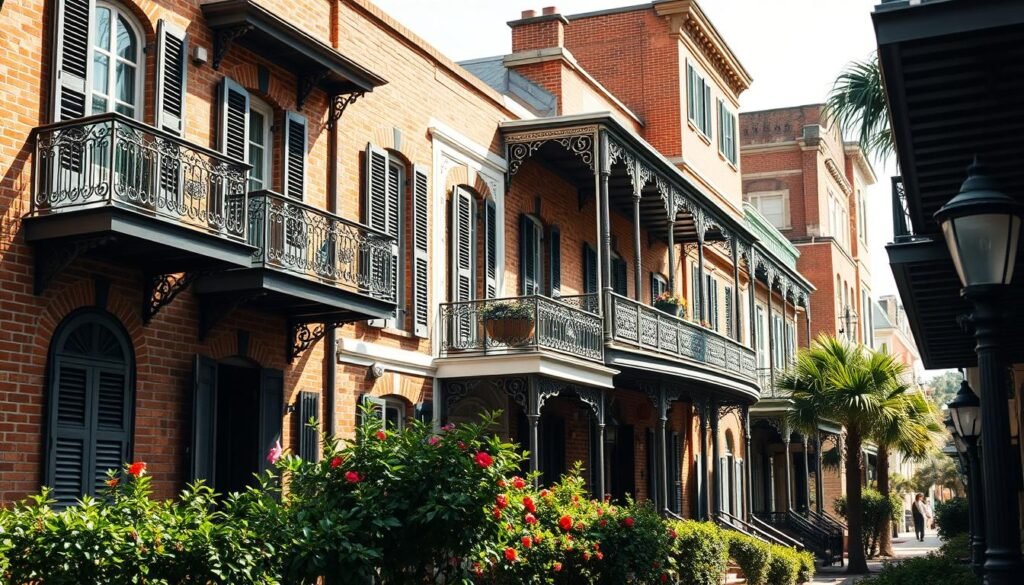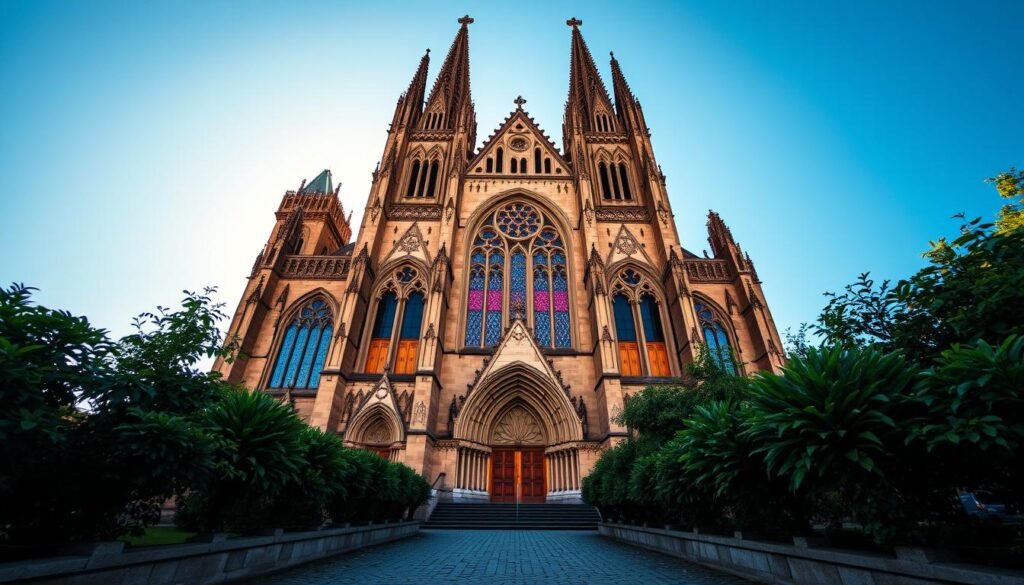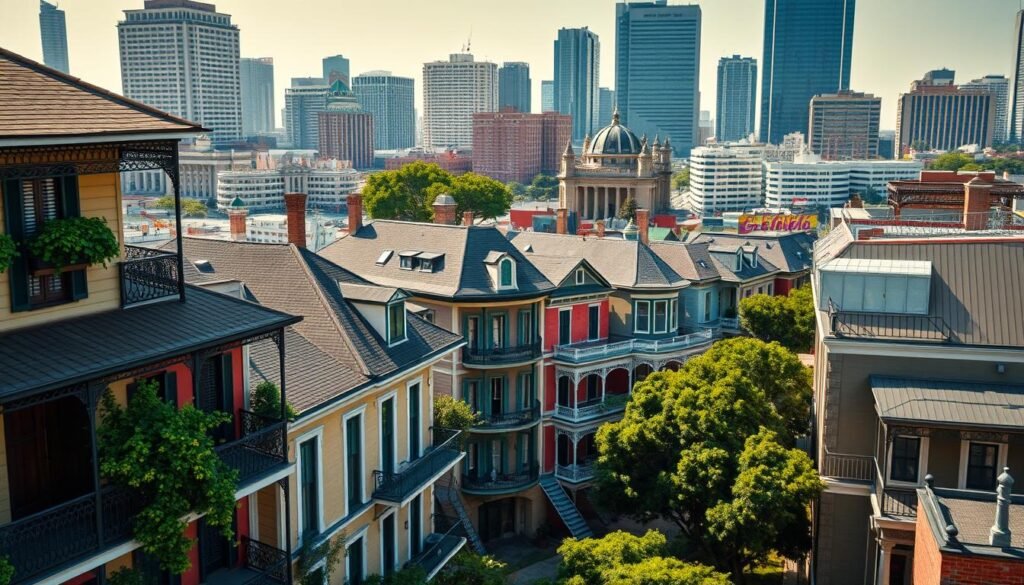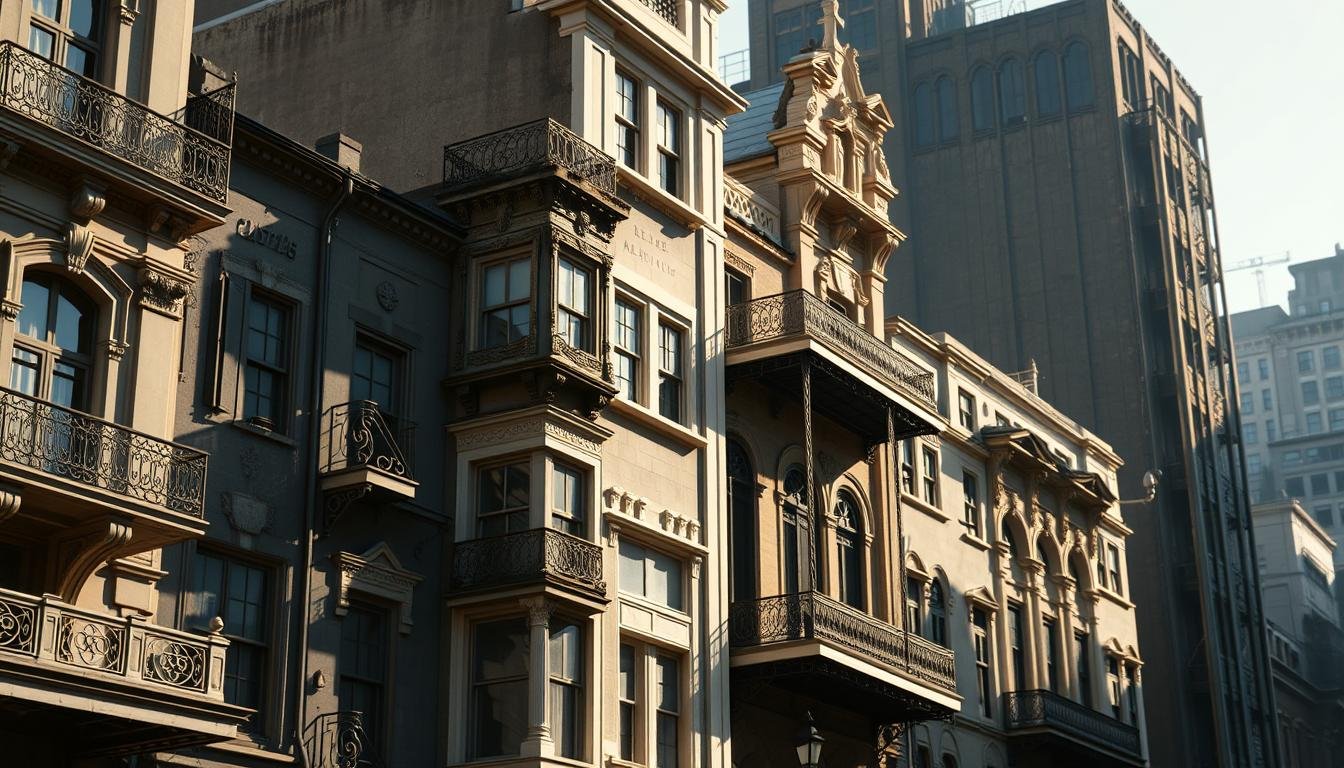As a local, I’m excited to share with you the rich architectural heritage of this vibrant city. From the historic French Quarter to the stunning Garden District, our city’s iconic structures are a captivating blend of cultures, styles, and history.
As we embark on this journey to explore the fascinating world of New Orleans architecture, we’ll delve into its history, iconic styles, and preservation efforts. We’ll discover how the city’s unique cultural landscape has shaped its built environment, creating a truly one-of-a-kind urban experience.
Key Takeaways
- Discover the rich history behind New Orleans architecture
- Explore the city’s iconic styles and historic buildings
- Learn about preservation efforts in the face of cultural and environmental challenges
- Understand how the city’s cultural landscape has shaped its built environment
- Experience the unique urban landscape of New Orleans
The Rich History Behind New Orleans Architecture
New Orleans’ architecture is a melting pot of history, reflecting the city’s diverse cultural heritage. As a city that’s been under the influence of various European powers, including France and Spain, and later becoming part of the United States, New Orleans has developed a unique architectural identity that’s both fascinating and complex.
The history of New Orleans’ architecture is not just about the buildings themselves, but about the people who built them, the events that shaped the city, and the cultural traditions that were brought to its shores. As we explore the rich history behind New Orleans architecture, we’ll delve into the colonial styles that laid the foundation for the city’s building traditions, the role of Spanish and French designers in shaping the city’s aesthetic, and how the city rebuilt after Hurricane Katrina.
Influence of Colonial Styles
The colonial era had a profound impact on the architectural landscape of New Orleans. The city’s early buildings were influenced by the French and Spanish, who brought their own distinct architectural styles to the New World. For instance, the use of balconies and ornate ironwork became a hallmark of New Orleans architecture, reflecting the city’s tropical climate and the cultural exchange between Europe and the Americas.
“The architecture of New Orleans is a testament to the city’s history as a melting pot of cultures, with influences from Europe, Africa, and the Caribbean.” – Wikipedia on New Orleans Architecture
The French and Spanish colonial styles are evident in the French Quarter, where buildings feature steeply pitched roofs, galleries, and decorative ironwork. These styles were adapted to the local climate, with large overhangs to protect against the sun and rain. The result is a unique blend of European and tropical influences that define the city’s architectural character.
The Role of Spanish and French Designers
Spanish and French designers played a crucial role in shaping the architectural identity of New Orleans. Their designs not only reflected the tastes of their homelands but also adapted to the local context, incorporating materials and techniques that were available in the region. The influence of these designers can be seen in the grand buildings of the French Quarter, such as the St. Louis Cathedral, which has become an iconic symbol of the city.
The table below highlights some key architectural features influenced by Spanish and French designers:
| Feature | Description | Influence |
|---|---|---|
| Balconies | Ornate ironwork balconies | French and Spanish |
| Roofing | Steeply pitched roofs | French |
| Galleries | Covered walkways | Spanish |
Impact of Hurricane Katrina on Reconstruction
Hurricane Katrina had a devastating impact on New Orleans, with widespread flooding and destruction of homes and buildings. The aftermath of the hurricane led to a significant rebuilding effort, with a focus on creating more resilient and sustainable architecture. The reconstruction efforts not only restored damaged buildings but also brought new ideas and innovations to the city’s architectural landscape.
The rebuilding process was guided by a mix of preservationists, architects, and community leaders who sought to maintain the city’s historic character while incorporating modern standards of sustainability and disaster resilience. As a result, New Orleans has emerged with a renewed architectural identity that honors its past while embracing the future.
Iconic Architectural Styles in New Orleans
From Creole cottages to Greek Revival mansions, the city’s iconic architectural styles are a testament to its diverse history. New Orleans is renowned for its unique blend of cultural influences, and its architecture is no exception.
Creole Cottages: A Blend of Cultures
Creole cottages are quintessential New Orleans dwellings, characterized by their simple yet elegant design. These structures often feature a cladding of stucco or brick, with a wide, wrap-around porch that invites relaxation. The influence of various cultures, including French, Spanish, and African, is evident in the design elements and decorative features.
Greek Revival Homes in the Garden District
The Garden District is famous for its stunning Greek Revival homes, which showcase the city’s architectural prowess during the 19th century. These homes are distinguished by their bold front facades, often adorned with impressive columns and intricate detailing. The use of porches and galleries adds to the grandeur, creating a sense of stateliness.
Italianate and Victorian Influences
Italianate and Victorian architectural styles also have a significant presence in New Orleans, reflecting the city’s cultural exchange and architectural innovation. Italianate buildings are known for their ornate brackets and tall, narrow windows, while Victorian homes display a mix of Gothic and classical elements. These styles contribute to the rich tapestry of the city’s architectural landscape.
Notable Structures in the French Quarter
New Orleans’ French Quarter is home to a plethora of historic sites that showcase the city’s rich architectural heritage. As you explore this vibrant neighborhood, you’ll discover a mix of grand landmarks and charming spots that have become synonymous with the city’s identity.
The St. Louis Cathedral: A Religious Landmark
The St. Louis Cathedral stands proudly in Jackson Square, its stunning architecture a testament to the city’s deep religious roots. This cathedral is not just a place of worship; it’s a symbol of the French Quarter’s historical and cultural significance.
Built in the 18th century, the cathedral has undergone several reconstructions, with the current structure being a blend of various architectural styles. Its presence in the French Quarter is a reminder of the area’s rich history and its importance as a religious hub.
Jackson Square: A Historic Gathering Place
Jackson Square is more than just a picturesque park; it’s a historic gathering place that has witnessed the evolution of New Orleans. Surrounded by street performers, artists, and charming cafes, the square is a vibrant hub of activity.
The square’s design, with its walking paths and green spaces, provides a serene escape from the bustling city. It’s also a popular spot for locals and tourists alike to relax and enjoy the surroundings.
La Maison de la Presse: An Architectural Gem
La Maison de la Presse is a charming example of the French Quarter’s architectural charm. This historic building, now home to a newsstand and coffee shop, retains much of its original character.
Visitors can appreciate its classic design elements, which reflect the architectural styles prevalent during its time. It’s a small but significant part of the French Quarter’s architectural tapestry.
| Landmark | Architectural Style | Historical Significance |
|---|---|---|
| St. Louis Cathedral | Colonial, Gothic Revival | Religious and cultural icon |
| Jackson Square | French Colonial | Historic gathering place |
| La Maison de la Presse | Creole | Preservation of historic architecture |
The Allure of Creole Townhouses
Creole townhouses are a defining feature of New Orleans’ architectural landscape, blending cultures and styles in a way that’s quintessentially the city. These charming structures, with their characteristic balconies and intricate ironwork, have become synonymous with the city’s historic districts.
The allure of Creole townhouses lies not just in their aesthetic appeal but also in their historical significance. They represent a unique blend of French, Spanish, and African influences, reflecting the diverse cultural heritage of New Orleans.

Features of the Classic Townhouse Design
The classic Creole townhouse design is marked by several distinctive features, including:
- Narrow, multi-story facades that maximize space on small urban lots
- Decorative ironwork balconies that add a touch of elegance
- Large, lacy galleries that provide shade and outdoor living space
- Vibrant color schemes that reflect the city’s lively spirit
These design elements, combined with the use of local materials like cypress and brick, give Creole townhouses their unique character. As preservationist Mary Beth Betz notes, “Creole townhouses are not just buildings; they’re a way of life in New Orleans.”
Preservation Efforts in the French Quarter
Preserving Creole townhouses has been a priority for the city, especially in the historic French Quarter. Efforts to protect these architectural gems include:
| Preservation Method | Description | Impact |
|---|---|---|
| Restoration Projects | Focused on maintaining original materials and techniques | Preserves historical integrity |
| Zoning Regulations | Strict guidelines to maintain architectural consistency | Ensures new constructions blend with existing structures |
| Community Engagement | Educating residents and visitors about the importance of preservation | Fosters a culture of preservation |
As architectural historian, Dr. Patricia Cook says, “The preservation of Creole townhouses is crucial not just for maintaining the aesthetic appeal of our city, but for keeping the history and culture of New Orleans alive.”
Famous Creole Townhouses and Their Stories
Some Creole townhouses have become famous not just for their beauty but for the stories they tell. For example, the LaLaurie House, despite its dark history, is a notable example of Creole architecture, while the Gallier House showcases the life and work of renowned architect James Gallier.
“New Orleans is a city where history is lived, not just remembered, and its Creole townhouses are at the heart of this living history.” –
These townhouses, with their intricate designs and storied pasts, continue to captivate visitors and locals alike, serving as a tangible connection to the city’s rich cultural heritage.
The Significance of Ironwork in New Orleans
Ironwork in New Orleans is not just decorative; it’s a reflection of the city’s rich history and cultural heritage. For centuries, the intricate designs and ornate details of ironwork have been a hallmark of the city’s architecture, adding a touch of elegance and sophistication to its buildings.
Ornate Balconies: A Distinctive Feature
Wrought iron balconies are perhaps the most iconic feature of New Orleans’ ironwork. These balconies are not just functional; they are works of art that add a unique charm to the city’s historic districts. The French Quarter, in particular, is famous for its picturesque streets lined with buildings adorned with intricate iron balconies.
“The balconies of New Orleans are a testament to the city’s architectural identity,” says a local historian. “They reflect the blend of cultures and influences that have shaped the city over the centuries.”
The Historical Significance
The historical significance of ironwork in New Orleans cannot be overstated. It reflects the city’s history as a melting pot of cultures, with influences from Europe, Africa, and the Caribbean. The use of ironwork in architecture was initially a status symbol, indicating wealth and prestige. Over time, it became an integral part of the city’s architectural style, symbolizing the blend of cultures that define New Orleans.
Craftsmanship of Local Artisans
Local artisans have played a crucial role in creating the ironwork that adorns New Orleans’ buildings. Their craftsmanship is a continuation of a tradition that dates back centuries, with techniques passed down through generations. Today, these artisans continue to create intricate ironwork pieces that are both functional and beautiful, maintaining the city’s architectural heritage.
The art of ironwork is kept alive by skilled craftsmen who work tirelessly to create pieces that are not only aesthetically pleasing but also tell a story of the city’s history and culture. As one artisan notes, “Ironwork is more than just a craft; it’s a way of preserving our heritage.”
Modern Architecture in New Orleans
New Orleans isn’t just about history; it’s also embracing the future with modern architecture that’s as vibrant as the city itself. As we explore the contemporary styles emerging in the city, it’s clear that New Orleans is not just preserving its past but also innovating for the future.
Contemporary Styles Emerging in the City
The city’s architectural landscape is evolving, with contemporary styles that blend seamlessly with the historic. One of the most notable trends is the incorporation of sustainable design principles, reflecting a growing awareness of environmental issues. Buildings are being designed with green roofs, solar panels, and energy-efficient systems, reducing their carbon footprint while maintaining the city’s unique aesthetic.
For instance, the New Orleans Sustainable Building Center serves as a model for eco-friendly architecture, showcasing materials and techniques that minimize environmental impact. This building not only demonstrates sustainable practices but also acts as a community resource, educating visitors about green building.
- Innovative use of recycled materials in construction
- Integration of natural light to reduce energy consumption
- Advanced water management systems to mitigate flooding risks
Adaptive Reuse of Historical Structures
One of the most compelling aspects of modern architecture in New Orleans is the adaptive reuse of historical structures. This approach not only preserves the city’s rich history but also gives old buildings new life. From converting historic warehouses into trendy lofts to transforming old churches into vibrant community centers, adaptive reuse is breathing new vitality into the city’s neighborhoods.
“The art of preservation is not just about saving old buildings; it’s about giving them a new purpose, making them relevant to the community again.” –
A notable example is the St. Roch Market, a historic market that has been revitalized into a thriving hub of local food and culture. This project exemplifies how adaptive reuse can honor the past while serving the present.

Case Studies: Modern Projects
Several modern projects in New Orleans stand out for their innovative design and impact on the community. The New Orleans Museum of Art’s Besthoff Sculpture Garden is a prime example, featuring over 60 sculptures amidst beautifully landscaped gardens. This project not only enhances the cultural landscape but also provides a serene escape for residents and visitors alike.
Another significant project is the University of New Orleans’s Human Performance Center, which combines cutting-edge athletic facilities with sustainable design elements. Such projects demonstrate how modern architecture is enhancing the city’s infrastructure and quality of life.
| Project | Features | Impact |
|---|---|---|
| St. Roch Market | Revitalized historic market, local food, culture | Community hub, economic boost |
| Besthoff Sculpture Garden | Sculptures, landscaped gardens | Cultural enhancement, recreational space |
| Human Performance Center | Athletic facilities, sustainable design | Enhanced infrastructure, community health |
The Importance of Preservation in Architecture
New Orleans’ unique architectural heritage is preserved through the concerted efforts of numerous organizations and individuals. The city’s historic buildings are not just structures; they are a testament to the city’s history, culture, and resilience.
Preservation efforts in New Orleans are multifaceted, involving various stakeholders from government agencies to local community groups. These efforts are crucial in maintaining the city’s distinctive architectural identity.
Organizations Dedicated to Preservation
Several organizations play a vital role in preserving New Orleans’ architectural heritage. The Historic District Landmarks Commission is one such body that oversees the preservation of historic buildings in the city. Additionally, organizations like the Preservation Hall Foundation and the New Orleans Historic Voodoo Museum contribute to the preservation of the city’s cultural and architectural heritage.
Policies Impacting Architectural Conservation
Policies and regulations significantly impact architectural conservation in New Orleans. The city’s Historic Preservation Ordinance is a key piece of legislation that guides preservation efforts. Furthermore, the city’s inclusion in the National Register of Historic Places provides additional protections and incentives for preserving historic buildings.
| Policy/Regulation | Description | Impact on Conservation |
|---|---|---|
| Historic Preservation Ordinance | Guides preservation efforts in the city | Protects historic buildings from demolition or inappropriate alterations |
| National Register of Historic Places | Recognizes and protects historic sites | Provides incentives for preservation and restoration |
Community Involvement in Preservation Efforts
Community involvement is a crucial aspect of preservation efforts in New Orleans. Local residents, businesses, and community groups work together to protect and preserve the city’s historic buildings. Initiatives such as the “Adopt a Building” program and community-led restoration projects demonstrate the power of community involvement in preservation.
Through these combined efforts, New Orleans continues to preserve its unique architectural heritage, ensuring that the city’s historic buildings remain a vibrant part of its cultural landscape.
Unique Examples of Religious Architecture
With a blend of cultures and influences, New Orleans’ religious architecture stands out as a unique aspect of the city’s identity. The city’s churches, cathedrals, and other places of worship are not only significant for their spiritual importance but also for their architectural beauty and historical value.

St. Augustine Church: A Spiritual Marvel
St. Augustine Church, located in the Treme neighborhood, is one of the oldest African American Catholic churches in the United States. Its stunning architecture is a testament to the community’s resilience and faith. The church’s design reflects a mix of Gothic and Romanesque styles, with impressive stained glass windows that filter in vibrant colors, creating a serene atmosphere.
The Historic Trinity Episcopal Church
Trinity Episcopal Church, situated in the Uptown neighborhood, is another example of New Orleans’ rich religious heritage. This church is known for its striking Romanesque Revival architecture, characterized by its rounded arches and solid, fortress-like appearance. The church’s interior is equally impressive, featuring intricate woodwork and beautiful stained glass.
Architectural Styles of New Orleans Churches
New Orleans churches showcase a diverse range of architectural styles, reflecting the city’s cultural melting pot. Some common styles include:
- Romanesque Revival, characterized by rounded arches and a solid appearance
- Gothic Revival, known for pointed arches and intricate stone carvings
- Greek Revival, distinguished by its use of classical elements like columns
These styles not only add to the aesthetic appeal of the churches but also tell the story of the communities that built them.
Exploring New Orleans’ Historic Cemeteries
The city’s historic cemeteries are not just places of rest; they’re outdoor museums showcasing New Orleans’ rich history and architectural splendor. As a local, I’ve always been fascinated by the unique above-ground tombs and the stories they tell about the city’s past.
Above-Ground Tombs: A Local Tradition
New Orleans is known for its above-ground tombs, a necessity due to the city’s low elevation and high water table. This tradition, influenced by European and African cultures, has resulted in a distinctive cemetery landscape that’s both haunting and beautiful.
The tombs are constructed to withstand the test of time, with intricate stone carvings and ornate details that reflect the craftsmanship of local artisans. Walking through these cemeteries, you’re surrounded by a sense of history and community.
The Architectural Significance of Cemeteries
The architectural significance of New Orleans’ historic cemeteries cannot be overstated. These spaces are a testament to the city’s cultural heritage, showcasing a blend of architectural styles influenced by its European, African, and Caribbean roots.
From the grand mausoleums to the simple family tombs, each structure tells a story about the people who built them and the era in which they were constructed. The cemeteries are a living history of New Orleans, with architecture that reflects the city’s complex past.
Notable Cemeteries to Visit
New Orleans is home to numerous historic cemeteries, each with its own unique character and history. Some of the most notable include St. Louis Cemetery No. 1, known for its historic significance and the final resting place of Marie Laveau, the Voodoo Queen of New Orleans.
| Cemetery Name | Notable Features | Historical Significance |
|---|---|---|
| St. Louis Cemetery No. 1 | Intricate stone carvings, grand mausoleums | Oldest cemetery in New Orleans, final resting place of Marie Laveau |
| Lafayette Cemetery No. 1 | Ornate family tombs, Greek Revival architecture | Historic cemetery in the Garden District, reflects the area’s cultural heritage |
| St. Roch Cemetery | Votive candles, St. Roch shrine | Associated with the healing and protection, reflects the religious traditions of New Orleans |
Visiting these cemeteries offers a glimpse into New Orleans’ rich cultural heritage and architectural history. They are a must-see for anyone interested in exploring the deeper aspects of the city’s identity.
Neighborhoods and Their Architectural Identity
From the grandeur of the Garden District to the vibrant colors of Faubourg Marigny, New Orleans’ neighborhoods are a treasure trove of architectural diversity. Each neighborhood has its own unique character, shaped by history, culture, and the city’s laid-back spirit.

The Garden District: A Showcase of Beauty
The Garden District is perhaps one of the most photographed areas in New Orleans, with its stunning antebellum mansions and picturesque parks. What makes this neighborhood so captivating is its ability to blend opulence with elegance. Some of the key features include:
- Grand Greek Revival and Italianate mansions
- Lush gardens filled with oak trees and azaleas
- Intricate ironwork adorning balconies and galleries
Walking through the Garden District feels like stepping into a different era, where the past and present coexist harmoniously.
Treme: A Cultural and Architectural Hub
Treme is often referred to as the oldest African American neighborhood in the United States, and its architecture reflects this rich cultural heritage. The neighborhood is known for its:
- Historic Creole townhouses with distinctive shotgun styles
- Vibrant street art and murals celebrating African American culture
- Landmark buildings like the New Orleans African American Museum
Treme’s architecture is not just about buildings; it’s about the stories and traditions that have been woven into the fabric of the community.
Faubourg Marigny: Local Color and Charm
Faubourg Marigny, or “Marigny” as locals call it, is a neighborhood that embodies the city’s playful spirit. Known for its:
- Brightly colored Creole cottages and historic homes
- Lively nightlife and cultural events
- Artistic vibe, with numerous galleries and studios
Marigny’s architecture is a reflection of its history as a melting pot of cultures, where French, Spanish, and African influences come together in a celebration of color and creativity.
In conclusion, New Orleans’ neighborhoods offer a diverse tapestry of architectural styles, each telling a unique story about the city’s history, culture, and people. Whether you’re strolling through the Garden District, exploring Treme, or enjoying the vibrant colors of Faubourg Marigny, you’re experiencing the essence of New Orleans’ architectural identity.
The Role of Local Artists and Craftsmen
Local artists and craftsmen play a pivotal role in defining the aesthetic and cultural landscape of New Orleans. Their work not only beautifies the city but also tells the story of its history, resilience, and creativity.
Shaping the Architectural Landscape
Artists in New Orleans are continually shaping the city’s architectural identity through various mediums. From murals that adorn building facades to intricate mosaics that embellish historic structures, their work adds layers of depth and character to the urban landscape.
Murals, in particular, have become a staple of New Orleans’ street art scene, transforming blank walls into vibrant canvases that reflect the city’s spirit. These large-scale artworks often incorporate themes related to the city’s history, jazz heritage, and cultural icons.
Integrating Contemporary Design with Tradition
One of the hallmarks of New Orleans’ architectural charm is its ability to blend the old with the new. Local artists and craftsmen are at the forefront of this effort, integrating contemporary design elements with traditional techniques to create unique and captivating works.
For instance, modern ironwork designs often pay homage to the city’s historic ironwork heritage while incorporating fresh patterns and motifs. This blend of old and new not only preserves the city’s architectural legacy but also injects it with a modern vitality.
Community Art Projects and Their Influence
Community art projects are another vital aspect of how local artists contribute to New Orleans’ architectural landscape. These projects often bring together artists, residents, and local businesses to create public artworks that reflect the community’s character and values.
| Project | Location | Impact |
|---|---|---|
| Mural Restoration | French Quarter | Preserved historic art, enhanced neighborhood appeal |
| Community Mosaic | Treme | Fostered community engagement, added cultural landmark |
| Public Sculpture | Garden District | Contributed to the area’s aesthetic, attracted tourism |
These community-driven initiatives not only beautify the city but also foster a sense of community and pride among residents. They demonstrate the powerful role that local artists and craftsmen play in shaping New Orleans’ unique cultural and architectural identity.
Tips for Exploring New Orleans Architecture
As we’ve explored the rich history, iconic styles, and notable structures that make New Orleans architecture so captivating, you’re probably eager to experience it firsthand. Whether you’re a local or just visiting, there are plenty of ways to dive deeper into the city’s architectural heritage.
Recommended Walking Tours
Join a guided architectural tour to discover hidden gems and learn about the history behind the buildings. From the grandeur of the Garden District to the vibrant colors of the Marigny, these tours offer a unique perspective on the city’s architectural landscape.
Essential Resources
For a self-guided tour, download apps and resources that highlight New Orleans’ architectural treasures. These tools will help you navigate the city’s historic neighborhoods and uncover the stories behind the buildings.
Cultural Celebrations
New Orleans is known for its cultural events, many of which celebrate the city’s architecture. Attend festivals and exhibitions that showcase the city’s rich heritage, from historic preservation efforts to contemporary design trends.
FAQ
What are the most iconic architectural styles in New Orleans?
New Orleans is known for its diverse architectural styles, including Creole cottages, Greek Revival homes, Italianate and Victorian influences, and more. These styles reflect the city’s rich cultural heritage and history.
What is the significance of ironwork in New Orleans architecture?
Ironwork is a distinctive feature of New Orleans architecture, particularly in the French Quarter and Garden District. Wrought iron balconies, intricate designs, and ornate details add a touch of elegance and sophistication to the city’s buildings.
How has Hurricane Katrina impacted New Orleans architecture?
Hurricane Katrina led to significant reconstruction efforts in New Orleans, with a focus on preserving the city’s historic architecture while incorporating modern and sustainable design elements.
What are some must-see architectural landmarks in the French Quarter?
The French Quarter is home to many iconic landmarks, including the St. Louis Cathedral, Jackson Square, and La Maison de la Presse. These structures showcase the city’s rich history and architectural heritage.
How can I explore New Orleans’ architecture on my own?
You can explore New Orleans’ architecture by taking a self-guided walking tour, using essential apps and resources, and attending cultural events celebrating the city’s architectural heritage.
What role do local artists and craftsmen play in shaping New Orleans’ architecture?
Local artists and craftsmen play a vital role in shaping New Orleans’ architectural landscape, integrating contemporary design with traditional techniques, and contributing to community art projects that enhance the city’s built environment.
Are there any notable architects associated with New Orleans?
Yes, New Orleans has been influenced by several notable architects, including James Gallier, Henry Howard, and Samuel Jamison, who have all contributed to the city’s unique architectural identity.
What preservation efforts are in place to protect New Orleans’ historic buildings?
Various organizations, including the Historic District Landmarks Commission, are dedicated to preserving New Orleans’ historic buildings. Community involvement and policies also play a crucial role in protecting the city’s architectural heritage.
